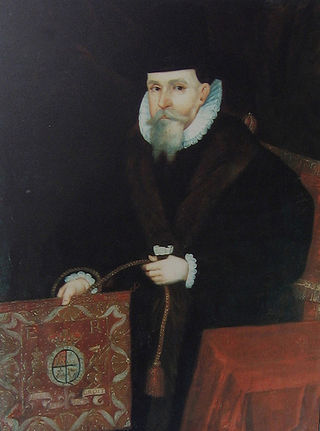| |||||
| Centuries: | |||||
|---|---|---|---|---|---|
| Decades: | |||||
| See also: | Other events of 1629 List of years in Ireland | ||||
The following is a list of events from the year 1629 in Ireland.
| |||||
| Centuries: | |||||
|---|---|---|---|---|---|
| Decades: | |||||
| See also: | Other events of 1629 List of years in Ireland | ||||
The following is a list of events from the year 1629 in Ireland.

Adam Loftus was Archbishop of Armagh, and later Dublin, and Lord Chancellor of Ireland from 1581. He was also the first Provost of Trinity College Dublin.

Holy Cross Abbey(Mainistir na Croise Naofa) was a Cistercian monastery in Holycross near Thurles, County Tipperary, Ireland, situated on the River Suir. It takes its name from a relic of the True Cross or Holy Rood.
Events from the year 1694 in Ireland.
Events from the year 1708 in Ireland.
Events from the year 1697 in Ireland.
Events from the year 1787 in Ireland.
Events from the year 1707 in Ireland.
Events from the year 1729 in Ireland.
Events from the year 1670 in Ireland.
Events from the year 1768 in Ireland.
Events from the year 1567 in Ireland.
Events from the year 1759 in Ireland.
Events from the year 1683 in Ireland.
Sir William Talbot, 1st Baronet, was an Irish lawyer and politician. He sat as MP for County Kildare in the Parliament of 1613–1615 and was in 1628 one of the negotiators of the Graces. However, he is probably mainly remembered as the father of Richard Talbot, 1st Earl of Tyrconnell.
Events from the year 1669 in Ireland.
Events from the year 1593 in Ireland.
Events from the year 1623 in Ireland.
Sir William Talbot, 3rd BaronetPC (Ire) was the last of the Talbot baronets of Carton: his title was forfeited on account of his loyalty to King James II of England. He was an Irish politician and judge, who served briefly as Master of the Rolls in Ireland.
Sir John Meade, 1st Baronet (1642–1707) was an Irish barrister, judge and politician. He was the first of the Meade Baronets of Balintubber, and an ancestor of the Earls of Clanwilliam. He was unusual among the lawyers of his time for his lack of ambition to become a judge of the High Court, despite being generally regarded as a barrister of "excellent parts (qualities)". In matters of religion, he seems to have been, by the standards of his time, a man of very tolerant views: although he was himself a Protestant, he damaged his career by marrying Elizabeth Butler, who was a Roman Catholic, as his third wife.
Michael Cox was an Anglican archbishop in Ireland during the 18th century. He is now chiefly remembered for building one of Ireland's most magnificent remaining mansions, Castletown Cox, near Carrick-on-Suir. A younger son of Sir Richard Cox, 1st Baronet, Lord Chancellor of Ireland from 1703 to 1707, and his wife Mary Bourne, he was born in Cork. He was educated at Kilkenny College and Christ Church, Oxford and ordained in 1713. He became Chaplain to Charles Butler, 1st Earl of Arran, then Rector of Calan and Chancellor of Kilkenny. In 1743 he became Bishop of Ossory; and in 1754, Archbishop of Cashel.